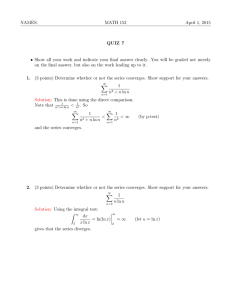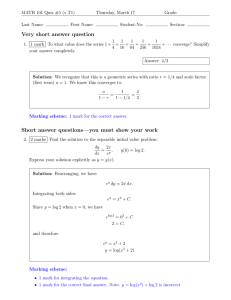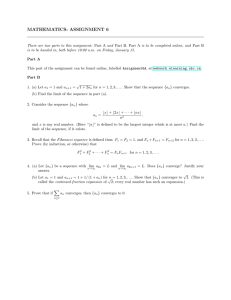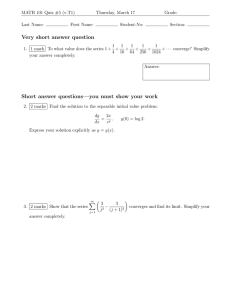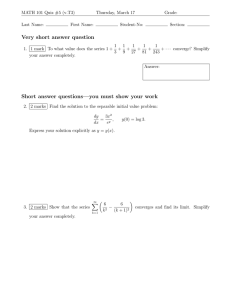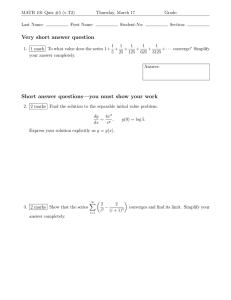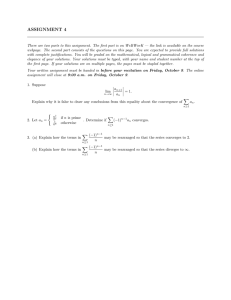Very short answer question
advertisement
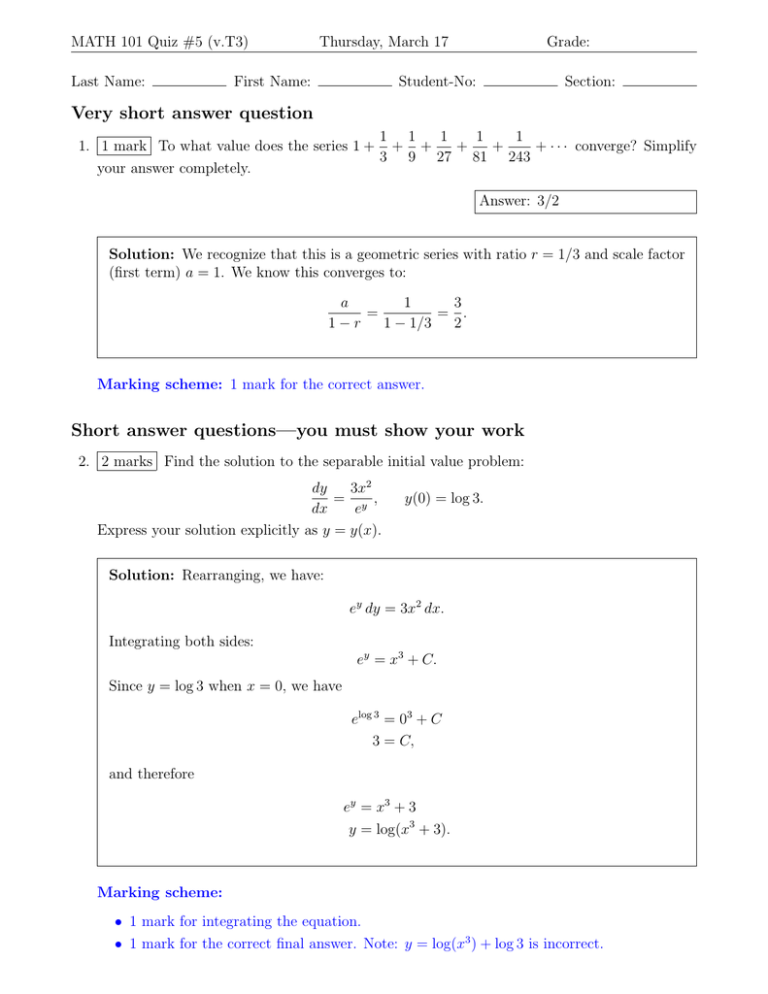
MATH 101 Quiz #5 (v.T3)
Last Name:
Thursday, March 17
First Name:
Grade:
Student-No:
Section:
Very short answer question
1 1
1
1
1
1. 1 mark To what value does the series 1 + + +
+
+
+ · · · converge? Simplify
3 9 27 81 243
your answer completely.
Answer: 3/2
Solution: We recognize that this is a geometric series with ratio r = 1/3 and scale factor
(first term) a = 1. We know this converges to:
a
1
3
=
= .
1−r
1 − 1/3
2
Marking scheme: 1 mark for the correct answer.
Short answer questions—you must show your work
2. 2 marks Find the solution to the separable initial value problem:
3x2
dy
= y ,
dx
e
Express your solution explicitly as y = y(x).
y(0) = log 3.
Solution: Rearranging, we have:
ey dy = 3x2 dx.
Integrating both sides:
ey = x3 + C.
Since y = log 3 when x = 0, we have
elog 3 = 03 + C
3 = C,
and therefore
ey = x3 + 3
y = log(x3 + 3).
Marking scheme:
• 1 mark for integrating the equation.
• 1 mark for the correct final answer. Note: y = log(x3 ) + log 3 is incorrect.
∞ X
6
6
3. 2 marks Show that the series
converges and find its limit. Simplify
−
k2
(k + 1)2
k=1
your answer completely.
Solution: We recognize this as a telescoping series. Successive terms cancel and the nth
partial sum is:
n X
6
6
6
6
= 2−
sn =
−
.
2
2
2
k
(k
+
1)
1
(n
+
1)
k=1
Therefore, we can see directly that the sequence of partial sums {sn } is convergent:
6
6
lim sn = lim
= 6.
−
n→∞
n→∞
12 (n + 1)2
It follows that the series is also convergent with limit 6.
Marking scheme: 2 marks for the correct answer with valid justification; 1 mark for a
correct procedure with minor errors. 1 mark for showing that the series converges by some
valid method without finding its value.
Long answer question—you must show your work
4. 5 marks The nth partial sum of a sequence {an } is known to have the formula sn =
1 + 3n
.
5 + 4n
(a) Find an expression for an , valid for n ≥ 2.
∞
X
an converges. (It will help to make the expression from part (a)
(b) Show that the series
n=1
a single fraction.)
(c) Find the value of the series
∞
X
an .
n=1
Solution: (a) We can find an by subtracting: an = sn − sn−1 .
1 + 3n 1 + 3(n − 1)
1 + 3n 3n − 2
−
=
−
5 + 4n 5 + 4(n − 1)
5 + 4n 4n + 1
(1 + 3n)(4n + 1) − (3n − 2)(4n + 5)
11
=
=
.
2
(4n + 1)(4n + 5)
16n + 24n + 5
an =
(b) Define f (x) = 11/(16x2 + 24x + 5), which is a positive and decreasing function for
x ≥ 1. Then an = f (n), and by the integral test, the series converges if and only if the
following integral converges:
Z ∞
Z ∞
11
f (x) dx =
dx.
16x2 + 24x + 5
1
1
We can see that this converges: for example, for x ≥ 1 we have 16x2 + 24x + 5 > 16x2 ,
and so by the integral comparison test:
Z ∞
Z ∞
Z R
11
11
11
11
dx <
dx = lim
dx = .
2
2
2
R→∞ 1 16x
16x + 24x + 5
16x
16
1
1
P
P∞ 1
11
Alternately, we can compare the series ∞
n=1 16n2 +24n+5 to the series
n=1 n2 , which converges by the p-test (2 > 1).
(c) To evaluate the limit of the series, we return to the partial sum sn originally given and
see that the sequence sn converges:
1/n + 3
3
1 + 3n
= lim
= .
n→∞ 5/n + 4
n→∞ 5 + 4n
4
lim sn = lim
n→∞
Marking scheme:
• 1 mark for (a), finding an (whether simplified or not).
• 2 marks for (b), a correct argument showing that the series converges. 1 mark partial
credit for good-faith attempts that include either a comparison test, an integral test, or
a p-test.
• 2 marks for (c), the correct evaluation of the limit of the series (regardless of whether
they proved convergence above).
